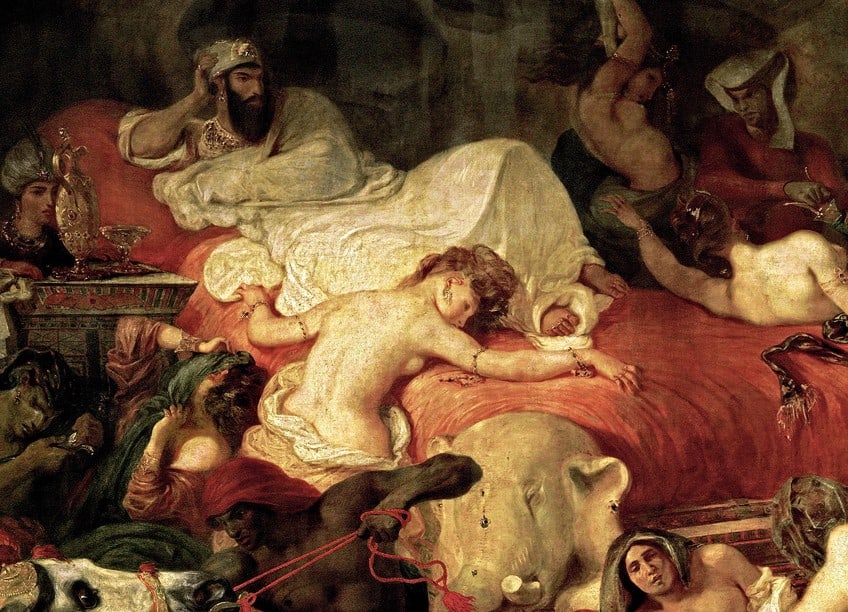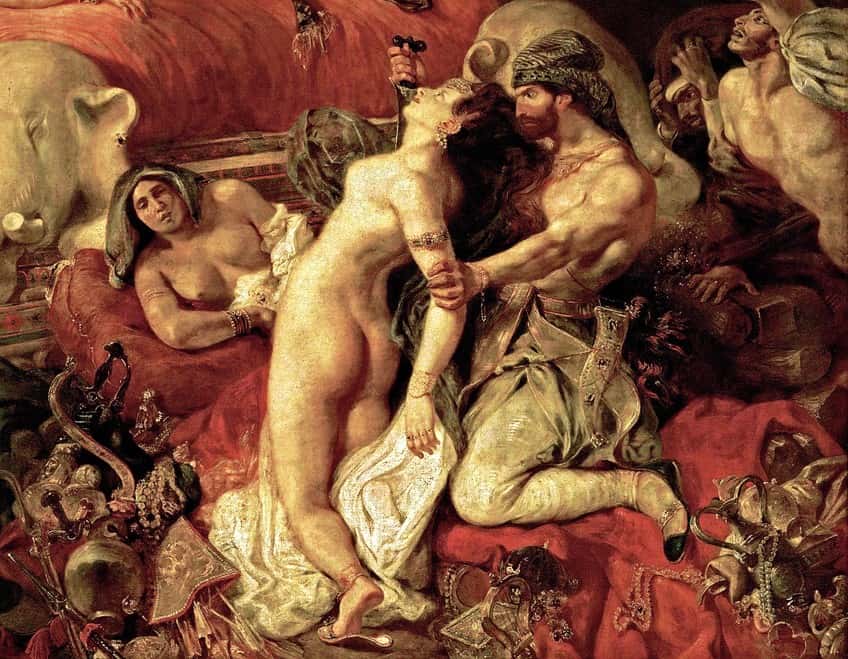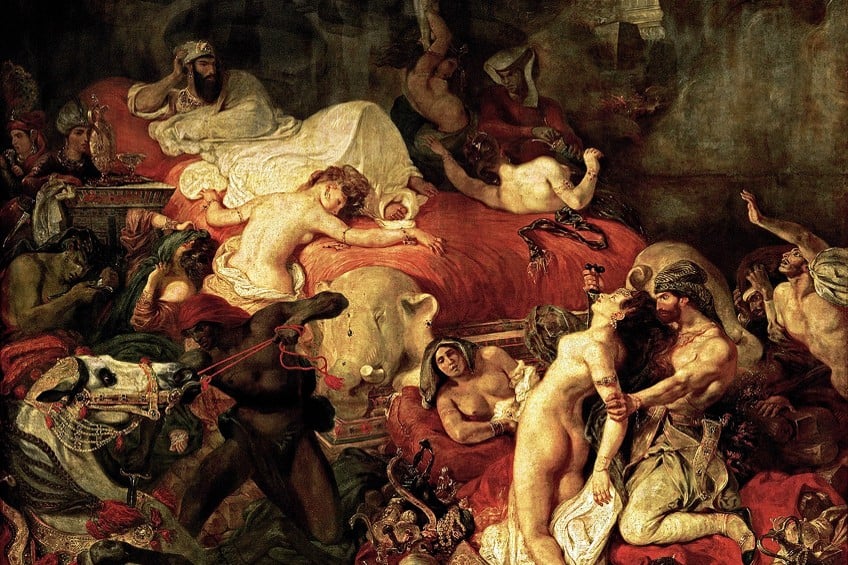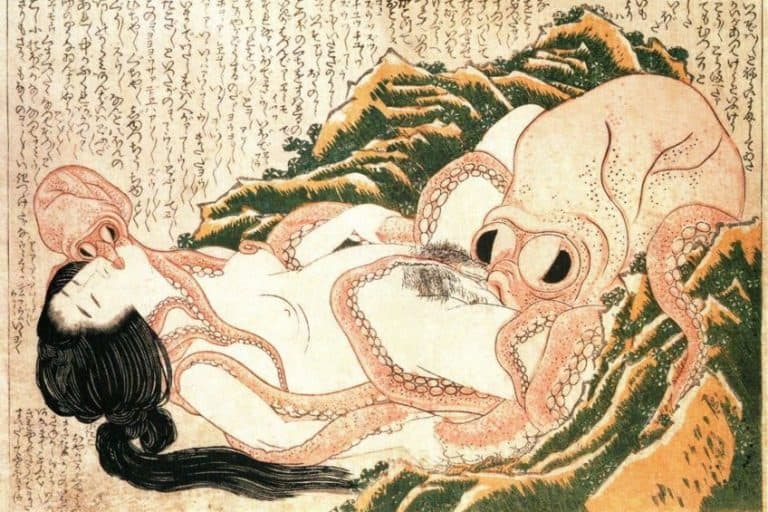“The Death of Sardanapalus” by Eugène Delacroix – A Quick Look
Eugène Delacroix was a key figure in the Romantic art movement of the 18th and 19th centuries. He was known for his expressive techniques that seemed to eschew those of the preceding Neoclassicism art style. This article will explore his controversial The Death of Sardanapalus (1827) painting that caused quite a stir during its exhibition. Let us take a closer look!
Artist Abstract: Who Was Eugène Delacroix?
Ferdinand-Victor-Eugène Delacroix was born in Charenton-Saint-Maurice in Paris on April 26, 1798, and died in Paris on August 13, 1863. He was a Romanticism painter who studied under artists like Pierre-Narcisse Guérin and touched on ideas of Orientalism in his art, having also traveled to places in North Africa.

His more expressive art style and utilization of colors were also an influence on the later Impressionism art movement. Several popular artworks by Delacroix include his Massacre at Chios (1824), Liberty Leading the People (1830), and Women of Algiers in their Apartment (1834).
The Death of Sardanapalus (1827) by Eugène Delacroix in Context
| Artist | Ferdinand-Victor-Eugène Delacroix (1798 – 1863) |
| Date Painted | 1827 |
| Medium | Oil on canvas |
| Genre | History painting |
| Period/Movement | Romanticism |
| Dimensions (meters) | 3.92 x 4.96 |
| Series/Versions | First of two versions. The second painting (replica) was created in 1844 and is housed at the Philadelphia Museum of Art in Pennsylvania, United States |
| Where Is It Housed? | Musée du Louvre, Paris, France |
| What It Is Worth | Purchased in 1921, reportedly by the Réunion des Musées Nationaux, for 700,000 francs |
The analysis of La Mort de Sardanapale, or in English, The Death of Sardanapalus, by Eugène Delacroix will discuss when the artist painted it and what inspired the subject matter, and who exactly Sardanapalus was. This will be followed by a visual description of the painting with a discussion of the elements of art composing it. It is important to note that Delacroix painted a replica of The Death of Sardanapalus in 1844, which is housed at the Philadelphia Museum of Art in Philadelphia, Pennsylvania, United States. This article will discuss the first, original, version created in 1827, which is held at the Musée du Louvre in Paris, France.
Contextual Analysis: A Brief Socio-Historical Overview
The Death of Sardanapalus by Eugène Delacroix was inspired by the play titled Sardanapalus (1821) by the English poet Lord Byron. Reportedly, the story of Sardanapalus has origins in the historical accounts by Diodorus Siculus, an ancient Greek historian from Sicily, who lived during the 1st century BC.
He wrote the grand text about world history titled “Bibliotheca Historica” (c. 60 – 30 BC), which comprised of forty books with three main sections, in which he mentioned Sardanapalus.

Who Was Sardanapalus?
Sardanapalus has been described as the last king of the Assyrians and specifically, the city called Nineveh, and who lived a lifestyle akin to a woman’s, wearing women’s clothing and makeup, and being completely immersed in a life of luxury and indulgence.
According to the story of how his city was besieged by rebels, the king eventually created a pyre inside his kingdom and decided to burn all his riches, which included himself, his concubines, eunuchs, and animals. This was to prevent his enemies from taking it all.
There has been debate about who Sardanapalus truly was from the historical accounts, and some propose that he was the figure named Ashurbanipal, but that he could also have been Ashurbanipal’s brother, Shamash-shum-ukin.
A Smaller Version
There is a smaller version, or replica, of La Mort de Sardanapale that Eugène Delacroix completed in 1844. It is housed at the Philadelphia Museum of Art in Pennsylvania, United States. It is believed that Delacroix painted the smaller version for his personal collection.

Formal Analysis: A Brief Compositional Overview
The oil on canvas titled The Death of Sardanapalus by Eugène Delacroix will be discussed in more detail below in terms of its formal qualities. This will start with a visual description that will describe the subject matter and lead to a brief overview of the art elements and how these are utilized and arranged throughout the composition.

Subject Matter: Visual Description
The Death of Sardanapalus painting depicts a lively interior scene filled with six female figures consisting of the king’s concubines/wives, several slaves, and horses being killed and busy dying by who appears to be the king’s soldiers/guards. There are bejeweled objects, jewelry, fabrics, and cushions all scattered around a large red bed in the background center of the composition, upon which lies the Assyrian ruler named Sardanapalus in a reclining position.
His head is slightly leaning on his right hand and his right elbow is resting on the pillow. He is staring ahead of him at the deathly disarray around him, seemingly unperturbed by the turmoil around him. He sports a lengthy dark brown beard and wears a white turban and a white tunic. A jeweled earring hangs from his right ear while his left ear is out of our, the viewers’, view. There is also a ring on his little finger and rings on all his toes. There also appear to be jewels on his turban and clothing.
On the bed next to Sardanapalus (to his right, our left) is a dead woman, who has been described as Myrrha, who was reportedly the king’s most liked.
Her head is turned to the side, towards us the viewers, and both her arms are splayed out to her sides. She is fully naked only with a piece of fabric loosely draped around her waist. Starting around the left side of the composition, in the upper left corner, are two figures, possibly two younger boys/men or female servants, carrying a cup with a decanter, assumedly still serving the king.

Just below these two servants are two other figures. A woman leans with her back against the left side of the bed and covers her face with a green piece of fabric. A man sitting by her appears to be stabbing himself. In the lower-left corner of the composition is a man with a red turban on his head stabbing a white horse in the chest with his right hand while he pulls on red reins attached to the horse with his left hand.
Not too far from this man and the horse, positioned right in front of the bed, is a naked woman (partly covered with fabric below her bust) lying on her right side on a thick red cushion. She is facing us, the viewers, and appears somewhat dazed and possibly in the process of dying.
In front of her is a bearded man kneeling behind a naked woman and tightly holding onto her left upper arm with his left hand, while busy driving a knife either into her upper chest or throat with his right hand.
Slightly behind and to the right of this man and woman is another man coming into view from the middle edge of the composition, only his upper torso is visible, and the rest of his body is out of the compositional space. He is reaching out in desperation or agony to Sardanapalus on his bed. To this man’s right is the face of another man subtly visible between all the fabrics. He appears to have both of his hands covering his head as if to keep himself safe from the danger around him.

On the right portion of the composition, and on the left side of the bed (our right), are more figures. Another man is in the process of unsheathing his knife to kill another naked woman leaning helplessly with her back against the bed’s edge (her back is to us, the viewers, too). To the left of these two figures is another naked woman, whose lower torso is covered with fabric. She appears to have hung herself with a piece of cloth or is in the process of hanging herself. A fire is visible in the background of the composition with what appears to be smoke filling the space.
This is possibly the pyre that the king reportedly prepared for himself and his possessions.
Color
The color scheme of The Death of Sardanapalus consists of large areas of red, notably the king’s bed, which is completely draped in red. Other colors include greens, whites, beiges, blacks, and gold. There is a range of different skin tones, from figures with fair skin tones and others with darker skin tones. There is a contrast of light and dark, which is notable by the lighter area on the figure of Sardanapalus, highlighting his presence in the painting. This is contrasted by the darker shadowed areas along the corners of the composition and evident in the background.

Texture
Delacroix’s brushstrokes in The Death of Sardanapalus are expressive and dynamic with areas where the paint is thickly applied, which was characteristically how the artist painted. There is also implied texture, for example in the fabrics, which appear soft in its folds.
These are compared to the harder surface textures of the wood around the bed, for example, the large elephant head on the right (our left) corner of the bed.

Line
There is an assortment of a variety of types of lines that delineate the subject matter in The Death of Sardanapalus painting, some of which include curved, curled, straight, short, and long, and all create a dynamism and energized composition.

Shape and Form
The Death of Sardanapalus painting consists mainly of organic shapes and forms, which are created by the variety of lines mentioned above. These are often described as being more “free-flowing” or “irregular” in their appearance and are more naturalistic compared to geometric shapes or forms.
For example, the humans and animal figures, which appear in various contortions, create a sense of movement and dramatism in the scene.

Space
Delacroix depicts a filled compositional space in The Death of Sardanapalus painting. The figures in the foreground are more visible and lighter while the background appears darker and these contrasts of light and dark create depth and more of a three-dimensional space. Additionally, depth is also created through foreshortening, which is when subject matter is depicted in a receding manner, for example, the bed appears larger near the foreground and becomes smaller as it nears the background

A “Fanaticism of Ugliness”
The Death of Sardanapalus is classified within the Romanticism art movement and is a visually dense composition filled with figures dying and suffering, a true testament of the intensity of Delacroix’s artistic approach.

This painting has also been viewed in contrast to the orderly and symmetrical Neoclassical paintings due to Delacroix’s bold colors and subject matter. When The Death of Sardanapalus was exhibited at the Paris Salon in 1828, it received impassioned responses towards the subject matter with some calling it the “fanaticism of ugliness”.
While “The Death of Sardanapalus” may have been scornfully viewed back in the day, as they say, what we, the onlookers, view today is an encapsulating artwork. Although depicting horror, nudity, and suffering, it is also a depiction of Delacroix’s position as a leading painter that ushered in the new modes of expression in art, which moved from “ugliness” to beauty.
Frequently Asked Questions
Who Painted The Death of Sardanapalus?
The French Romanticist Ferdinand-Victor-Eugène Delacroix painted The Death of Sardanapalus (1827). It is an oil on canvas with measurements of 3.92 by 4.96 meters, and is at the Musée du Louvre in Paris, France.
What Is The Death of Sardanapalus About?
Eugène Delacroix’s The Death of Sardanapalus (1827) is about the Assyrian king who decided to destroy his riches and kill his slaves, women, and animals before they would be killed by his enemies who attacked his kingdom. It was inspired by the story told by the ancient Greek historian, Diodorus Siculus, and the later play titled Sardanapalus (1821) by Lord Byron.
Is There Another Version of The Death of Sardanapalus?
Eugène Delacroix created a replica of The Death of Sardanapalus (1827) painting in 1844, which is smaller than the original and measures 73.7 by 92.6 centimeters. It is an oil on canvas, which is housed at the Philadelphia Museum of Art in Pennsylvania, United States.
Alicia du Plessis is a multidisciplinary writer. She completed her Bachelor of Arts degree, majoring in Art History and Classical Civilization, as well as two Honors, namely, in Art History and Education and Development, at the University of KwaZulu-Natal, South Africa. For her main Honors project in Art History, she explored perceptions of the San Bushmen’s identity and the concept of the “Other”. She has also looked at the use of photography in art and how it has been used to portray people’s lives.
Alicia’s other areas of interest in Art History include the process of writing about Art History and how to analyze paintings. Some of her favorite art movements include Impressionism and German Expressionism. She is yet to complete her Masters in Art History (she would like to do this abroad in Europe) having given it some time to first develop more professional experience with the interest to one day lecture it too.
Alicia has been working for artincontext.com since 2021 as an author and art history expert. She has specialized in painting analysis and is covering most of our painting analysis.
Learn more about Alicia du Plessis and the Art in Context Team.
Cite this Article
Alicia, du Plessis, ““The Death of Sardanapalus” by Eugène Delacroix – A Quick Look.” Art in Context. August 30, 2023. URL: https://artincontext.org/the-death-of-sardanapalus-by-eugene-delacroix/
du Plessis, A. (2023, 30 August). “The Death of Sardanapalus” by Eugène Delacroix – A Quick Look. Art in Context. https://artincontext.org/the-death-of-sardanapalus-by-eugene-delacroix/
du Plessis, Alicia. ““The Death of Sardanapalus” by Eugène Delacroix – A Quick Look.” Art in Context, August 30, 2023. https://artincontext.org/the-death-of-sardanapalus-by-eugene-delacroix/.











